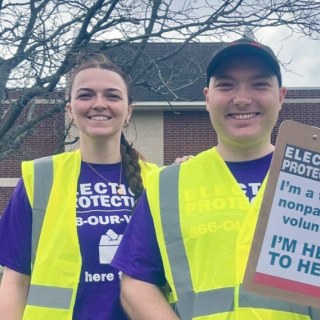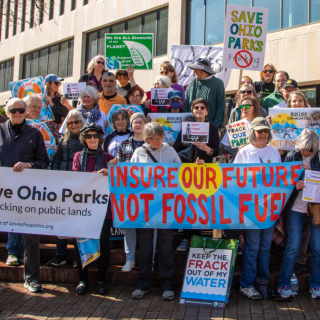Advertisement
This plant will create a demand for more fracking and will increase local air pollution in Columbus. Speak up for the climate and a livable planet for future generations!
The second public hearing on OSU’s proposed gas plant will be held remotely on Tuesday, August 4 at 6pm. Community members may give testimony by phone or by video conference using WebEx.
If you plan to testify, please register at this link by 12noon on Monday, August 3.
The hearing will be live-streamed on PUCO’s YouTube channel. If you will not be speaking, you may tune in and join us in live by tweeting #noosugas or by using the PUCO’s YouTube channel.
Hosted by Ohio Beyond Coal, Sierra Club Central Ohio Group and Sierra Club Ohio Chapter.
Background:
Op-Ed: OSU’s combined heat and power plant is a colonial nightmare by Austin MilesIn 1795, indigenous nations ceded much of the Ohio Country to the U.S. government as part of the Treaty of Greenville. The territory ceded as part of this treaty includes the land Ohio State University (OSU) resides on. The cession, as Roxanne Dunbar-Ortiz wrote, was “a victory based on vicious irregular warfare.” She recounts U.S. forces “destroying Shawnee villages and fields and murdering women, children, and old men.” The decisive defeat for the indigenous nations that spurred their acceptance of the treaty was the Battle at Fallen Timbers, yet even after their victory, U.S. forces “continued for three days laying waste to Shawnee houses and cornfields.”
Ohio State itself was founded as part of the Morrill Act of 1862, which distributed public domain lands to new universities for their use for fundraising. As the High Country News reported, the lands funneled through the Morrill Act were expropriated indigenous lands, acquired by the U.S through violence-backed treaties and meager payments or, often, outright theft. According to High Country News’ reporting, OSU received 614,165 acres of stolen land through the act, for which the U.S. paid $35,410 and OSU subsequently sold it for $340,818. Adjusted for inflation, that sum is $6,849,131. The amount is not much for OSU or other land-grants today, but as a fledgling institution, that money is one of the reasons OSU and other such universities were able to survive. As Sharon Stein, an assistant professor at the University of British Columbia, noted in High Country News’ article, “[t]here would be no higher education as we know it in the United States without the original and ongoing colonization of indigenous peoples and lands.” Like other land-grants, OSU is entangled in this original violence and is still entangled in the violences of settler colonialism—and has done well for it. Exploitation is the matrix in which OSU thrives.
Lately, OSU has doubled down, weaving itself into newer iterations of these violences. In 2011, OSU published a climate action plan in which it committed to achieving carbon neutrality by 2050. Ironically, one of the plan’s strategies was the construction of a combined natural gas-powered heat and power (CHP) facility on campus, which it cited as the “largest single carbon mitigation strategy currently being evaluated.” As letters to the editor in the Dispatch have pointed out, fracked natural gas is an environmental disaster and a nonsensical solution to the climate crisis. In 2017, OSU entered into a partnership with the French energy company ENGIE and the Canadian investment firm Axium Infrastructure in which the two would manage OSU’s energy systems for fifty years. As part of the partnership, the two corporations, forming an entity called Ohio State Energy Partners (OSEP), paid OSU $1 billion upfront and an additional $150 million committed to supporting academics. Just two years later, OSEP sought approval from OSU’s Board of Trustees to build the CHP plant, for which they would front the costs. The CHP plant, at this point, seems less like a good faith strategy for achieving sustainability and more like a cash grab reminiscent of OSU’s leasing of its parking services to QIC Global Infrastructure.
The plant is on the verge of being built and will lock OSU into fracked natural gas for at least ten years. Even one day is too long. The plant will be another node in the structures of colonial violence. As the geographer Bruce Braun has written, “[t]o understand fracking, we must also understand the processes in settler colonialism by which native land was and still is transformed into property.” Fracking in the U.S. is only possible under the conditions of dispossession and devastation. Many objecting to the prospect of the CHP plant cite the prospect of climate catastrophe or the pollution the plant will bring to the areas around the university, but as Braun notes, for indigenous people (as well as all subjugated by white supremacy) the catastrophe has already happened and is still happening. The CHP plant will not be a cause of catastrophe. The catastrophe is the environment out of which the plant emerges—without catastrophe, the plant would not be possible.
I haven’t been able to figure out where OSU would source the gas for the CHP plant. Maybe I haven’t been thorough enough; maybe OSU, Axium, and ENGIE have purposefully obfuscated potential sources; maybe the opaqueness is down to the vagaries of the energy markets. In any case, whether the natural gas comes from the U.S. and Canada, or elsewhere, inevitably much of it, if not all, will be the result of various types of colonialism, and all natural gas is entangled in extractive capitalism. It cannot be part of any project whose aim is sustainability. Nonetheless I don’t blindly advocate for renewables either. Writing about lithium mining in Chile, Thea Riofrancos notes that renewable technologies require “green extractivism,” that is, “the subordination of human rights and ecosystems to endless extraction in the name of ‘solving’ climate change.” She continues later on, “every wind turbine, solar panel, and electric vehicle requires vast quantities of materials mined from the earth, transported in container ships over great distances, manufactured in factories likely still powered by coal, and transported again to consumers.” Instead of unquestioningly enrolling these exploitative supply chains in their quest for carbon neutrality, OSU must find solutions to the climate crisis that not only refuse these colonial formations but seek their dissolution. I don’t know what these solutions look like. I’m not the one to talk to anyways—I’m a settler. OSU needs to talk with expelled nations like the Shawnee on whose land OSU now resides, or those whose dispossession initially funded OSU, or those whose land is exploited in the name of carbon neutrality. Maybe solutions to the climate crisis won’t involve the university at all. After all, I’ve called for a decolonial approach to climate change, and decolonization—whose main objectives are restoration of land to indigenous peoples and restoration of indigenous lifeways—seems incommensurable with OSU’s continued existence.
Austin Miles is graduate student at OSU's School of Environment and Natural Resources and a resident of the University District.



